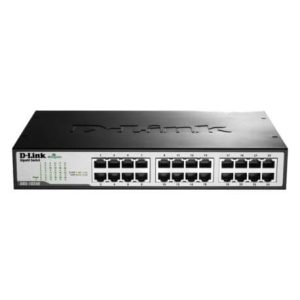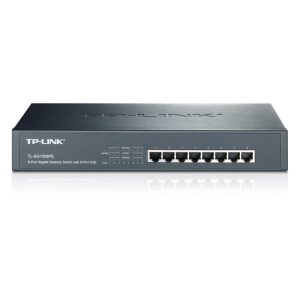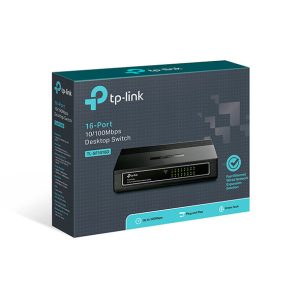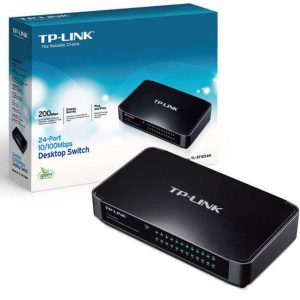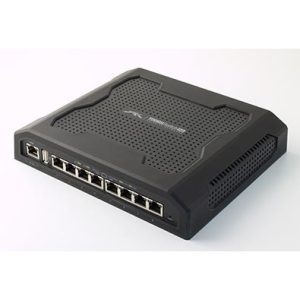Switches
Showing all 9 results
-
Brands, Switches, TP-Link
TP-LINK 8-Port Gigabit POE Switch (TL-SG1008PE)
Key Features.
- 8 10/100/1000Mbps RJ45 ports
- Equipped with 8 PoE+ supported ports to transfer data and power over a single cable
- Works with IEEE 802.3af/at compliant devices, expanding home and office networks
- Innovative energy-efficient technology reduces power output by up to 75%*
- Plug and play design, no configuration required
SKU: DC00023 -
Brands, Networking, Switches, TP-Link
Tp-Link TL-SF1008D10/100mbps 8-Port Desktop Switch
- PLUG-AND-PLAY – Easy setup with no configuration or no software needed
- ETHERNET SPLITTER – Connectivity to your router or modem router for additional wired connections
- 8 Port FAST ETHERNET – 8 10/100 Mbps Fast Ethernet auto-negotiation RJ45 ports greatly expand network capacity.
- COST EFFECTIVE
- RELIABLE – IEEE 802.3x flow control provides reliable data transfer
- UP to 60% Power Saving – Automatically adjusts power consumption according to the link status and cable length
SKU: n/a -
Brands, Networking, Switches, TP-Link
TP-Link TL-SF1016D 16-Port 10/100Mbps Desktop Switch
Key Features.
- 16 10/100Mbps Auto-Negotiation RJ45 ports, Supports Auto MDI / MDIX
- Green Ethernet technology saves the power up to 80%
- IEEE 802.3x flow control provides reliable data transfer
- Plastic case, desktop or wall-mounting design
- Plug and play, no configuration required
SKU: n/a
Buy network switches at an affordable price in Kenya only at Dove Computers.
Network switches are now available for the best price only at Dove Computers. A network switch is a device that connects multiple devices in a local area network (LAN), allowing them to communicate with each other. It works by receiving data packets from one device and forwarding them to the appropriate destination device, based on the Media Access Control (MAC) addresses of the devices.
Unlike a hub, which broadcasts data to all connected devices, a switch routes data to specific devices only, which makes the network more efficient and secure. This is because only the intended recipient device will receive the data, reducing unnecessary network traffic and improving overall network performance.
A network switch may have multiple ports, allowing you to connect multiple devices to your network, such as computers, printers, servers, and other network-enabled devices. It may also come with advanced features, such as Quality of Service (QoS), VLAN (Virtual Local Area Network) support, and link aggregation, which help to manage and optimize network traffic.
Switches can be managed or unmanaged, with managed switches offering more advanced features and greater control over network traffic, while unmanaged switches are simpler to use and generally less expensive.
What to consider when purchasing a network switch
- Port count: The first thing you should consider is the number of ports you need. You should select a switch with enough ports to connect all your devices, including computers, printers, servers, and other networked devices.
- Speed: The speed of the switch is also important. Switches come in different speeds, such as 10/100/1000 Mbps, 10 Gbps, and 40 Gbps. You should select a switch that can handle the traffic volume and speed requirements of your network.
- Type: There are different types of switches, including managed, unmanaged, and smart switches. Managed switches offer advanced features such as VLANs, QoS, and SNMP, while unmanaged switches are simple and easy to set up. Smart switches offer a mix of features from both types. You should select a switch type that meets your network requirements.
- Power over Ethernet (PoE): If you have devices such as wireless access points, IP cameras, and VoIP phones that require power, you should consider a switch with PoE capabilities. PoE allows you to power devices over the Ethernet cable, eliminating the need for separate power sources.
- Stacking: If you have multiple switches in your network, you should consider a switch with stacking capabilities. Stacking allows you to manage multiple switches as a single entity, simplifying network management.
Uses of a network switch
- Connecting multiple devices to a network: A network switch allows you to connect multiple devices, such as computers, servers, printers, and other network-enabled devices, to a local area network (LAN). This makes it possible for devices to communicate with each other and share resources.
- Improving network performance: A switch routes data to specific devices only, reducing network traffic and improving overall network performance. This is because only the intended recipient device will receive the data, which reduces unnecessary network traffic and improves overall network speed.
- Supporting high-bandwidth applications: A network switch can support high-bandwidth applications, such as video streaming, online gaming, and large file transfers, by providing fast data transfer rates and low latency.
- Creating VLANs: A switch can create Virtual Local Area Networks (VLANs), which allow you to segment your network into separate virtual networks, each with its own security policies, access controls, and performance characteristics.
- Providing advanced network management features: Managed switches offer advanced features, such as Quality of Service (QoS), Link Aggregation Control Protocol (LACP), Spanning Tree Protocol (STP), and Port Mirroring, which allow you to manage and optimize network traffic.


